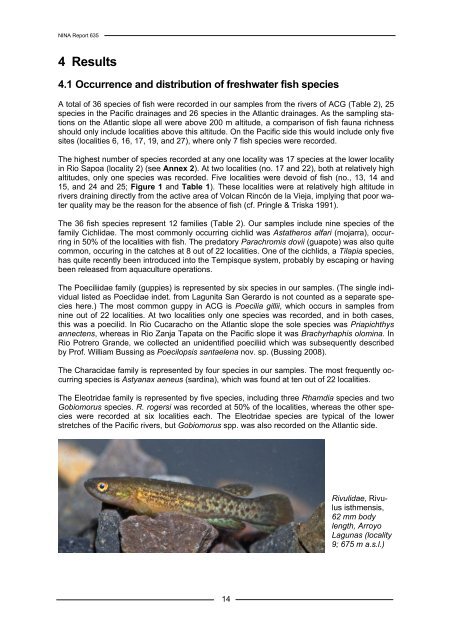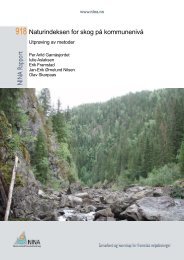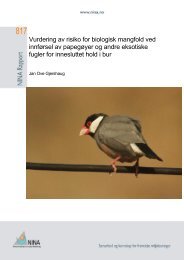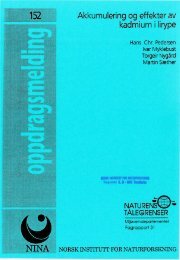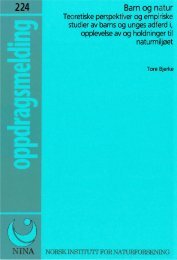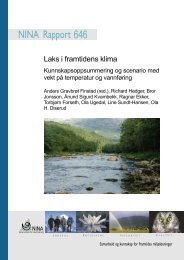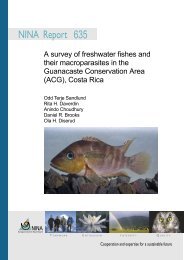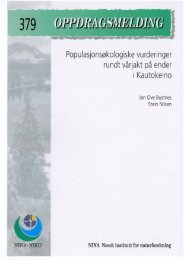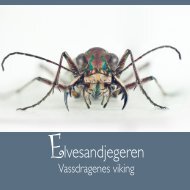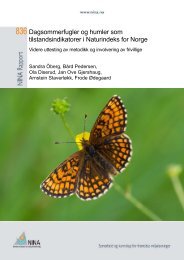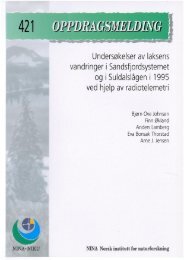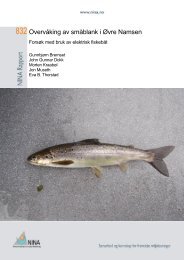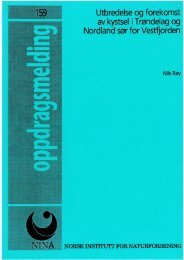A survey of freshwater fishes and their macroparasites in the ... - NINA
A survey of freshwater fishes and their macroparasites in the ... - NINA
A survey of freshwater fishes and their macroparasites in the ... - NINA
Create successful ePaper yourself
Turn your PDF publications into a flip-book with our unique Google optimized e-Paper software.
<strong>NINA</strong> Report 635<br />
4 Results<br />
4.1 Occurrence <strong>and</strong> distribution <strong>of</strong> <strong>freshwater</strong> fish species<br />
A total <strong>of</strong> 36 species <strong>of</strong> fish were recorded <strong>in</strong> our samples from <strong>the</strong> rivers <strong>of</strong> ACG (Table 2), 25<br />
species <strong>in</strong> <strong>the</strong> Pacific dra<strong>in</strong>ages <strong>and</strong> 26 species <strong>in</strong> <strong>the</strong> Atlantic dra<strong>in</strong>ages. As <strong>the</strong> sampl<strong>in</strong>g stations<br />
on <strong>the</strong> Atlantic slope all were above 200 m altitude, a comparison <strong>of</strong> fish fauna richness<br />
should only <strong>in</strong>clude localities above this altitude. On <strong>the</strong> Pacific side this would <strong>in</strong>clude only five<br />
sites (localities 6, 16, 17, 19, <strong>and</strong> 27), where only 7 fish species were recorded.<br />
The highest number <strong>of</strong> species recorded at any one locality was 17 species at <strong>the</strong> lower locality<br />
<strong>in</strong> Rio Sapoa (locality 2) (see Annex 2). At two localities (no. 17 <strong>and</strong> 22), both at relatively high<br />
altitudes, only one species was recorded. Five localities were devoid <strong>of</strong> fish (no., 13, 14 <strong>and</strong><br />
15, <strong>and</strong> 24 <strong>and</strong> 25; Figure 1 <strong>and</strong> Table 1). These localities were at relatively high altitude <strong>in</strong><br />
rivers dra<strong>in</strong><strong>in</strong>g directly from <strong>the</strong> active area <strong>of</strong> Volcan R<strong>in</strong>cón de la Vieja, imply<strong>in</strong>g that poor water<br />
quality may be <strong>the</strong> reason for <strong>the</strong> absence <strong>of</strong> fish (cf. Pr<strong>in</strong>gle & Triska 1991).<br />
The 36 fish species represent 12 families (Table 2). Our samples <strong>in</strong>clude n<strong>in</strong>e species <strong>of</strong> <strong>the</strong><br />
family Cichlidae. The most commonly occurr<strong>in</strong>g cichlid was Asta<strong>the</strong>ros alfari (mojarra), occurr<strong>in</strong>g<br />
<strong>in</strong> 50% <strong>of</strong> <strong>the</strong> localities with fish. The predatory Parachromis dovii (guapote) was also quite<br />
common, occur<strong>in</strong>g <strong>in</strong> <strong>the</strong> catches at 8 out <strong>of</strong> 22 localities. One <strong>of</strong> <strong>the</strong> cichlids, a Tilapia species,<br />
has quite recently been <strong>in</strong>troduced <strong>in</strong>to <strong>the</strong> Tempisque system, probably by escap<strong>in</strong>g or hav<strong>in</strong>g<br />
been released from aquaculture operations.<br />
The Poeciliidae family (guppies) is represented by six species <strong>in</strong> our samples. (The s<strong>in</strong>gle <strong>in</strong>dividual<br />
listed as Poeclidae <strong>in</strong>det. from Lagunita San Gerardo is not counted as a separate species<br />
here.) The most common guppy <strong>in</strong> ACG is Poecilia gillii, which occurs <strong>in</strong> samples from<br />
n<strong>in</strong>e out <strong>of</strong> 22 localities. At two localities only one species was recorded, <strong>and</strong> <strong>in</strong> both cases,<br />
this was a poecilid. In Rio Cucaracho on <strong>the</strong> Atlantic slope <strong>the</strong> sole species was Priapichthys<br />
annectens, whereas <strong>in</strong> Rio Zanja Tapata on <strong>the</strong> Pacific slope it was Brachyrhaphis olom<strong>in</strong>a. In<br />
Rio Potrero Gr<strong>and</strong>e, we collected an unidentified poeciliid which was subsequently described<br />
by Pr<strong>of</strong>. William Buss<strong>in</strong>g as Poecilopsis santaelena nov. sp. (Buss<strong>in</strong>g 2008).<br />
The Characidae family is represented by four species <strong>in</strong> our samples. The most frequently occurr<strong>in</strong>g<br />
species is Astyanax aeneus (sard<strong>in</strong>a), which was found at ten out <strong>of</strong> 22 localities.<br />
The Eleotridae family is represented by five species, <strong>in</strong>clud<strong>in</strong>g three Rhamdia species <strong>and</strong> two<br />
Gobiomorus species. R. rogersi was recorded at 50% <strong>of</strong> <strong>the</strong> localities, whereas <strong>the</strong> o<strong>the</strong>r species<br />
were recorded at six localities each. The Eleotridae species are typical <strong>of</strong> <strong>the</strong> lower<br />
stretches <strong>of</strong> <strong>the</strong> Pacific rivers, but Gobiomorus spp. was also recorded on <strong>the</strong> Atlantic side.<br />
14<br />
Rivulidae, Rivulus<br />
isthmensis,<br />
62 mm body<br />
length, Arroyo<br />
Lagunas (locality<br />
9; 675 m a.s.l.)


